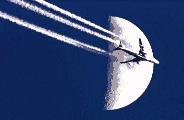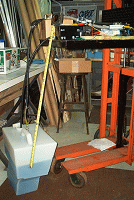Contrails ! 914 Fuel System Testing
Testing fuel supply
The most common source of trouble on a homebuilt aircraft is related to fuel supply
Europa builders Ron Parigoris and Wayne Gutschow share their findings on the Rotax 914 fuel pumps prior to installation in their project.
Although their comments mainly apply to the Europa fuel system, this report may be of interest to all homebuilders installing a Rotax 914.
Fuel system testing by Ron Parigoris & Wayne Gutschow
I will share with group my boring findings about 914 fuel pumps. Testing 01-07-2007.
Modular fuel system
We are using Europa's recommended schematic, only difference is using two Andair 375 gascolators instead of the supplied filters.
2 fittings aft of gascolator box are home grown tank water drains made from 6020 aluminium, the forward one has a restricted nipple that feeds my ground use only sight gauge.
4 bolts remove modular gascolator top, and 2 screws removes modular pumps, 1 ways and manifold.
Sealed box contains 2 Andair 375 Gascolators accessible outside aft of port wing.
The Andair 375 (right) has a pleated filter with far more surface area than the Andair Mini (left).
Keep in mind that flow through the 914 fuel system is more than just what the engine uses. This is due to the amount returned to tank.
Test connections
Used a 12 volt 12 amp Gel Cell Battery, ~ 12.6V static, 1 pump loaded to almost stall ~12.2V and 2 pumps loaded to almost stall ~11.8V.
Additional filters
For testing I added supplied clear filters between gascolator and pump input, and a clear automotive filter with a pleated orangish paper looking element at the output of fuel system.
These 3 filters are for test only to protect the pump intake filters and fuel supply that went back into the neighbors Comanche.
I used my aux fuel tank with 7.5 gallons of filtered 100LL.
Break in run
I ran pumps one at a time for 2 hours each (no suction head) before I did testing, so they should
have been broken in.
Manual states 20% increase (I forget if it was flow
or pressure) after break in.
The output filter was black as the fuel hoses!
The gascolators and filters between gascolator and input of pumps were clean of the black.
I called Kerry at Lockwood and he thought it may be Molykote used in pump assembly ??
Note there is a finger filter in the intake of each 914 fuel pump, Lockwood suggests cleaning annual or every
100 hours.
Note that these filters just
pull out, but can't get a replacement, so be careful.
Probably a good deal not running P2 along with P1 at first so as not put any black into P2 sock filter.
Pump flow
P1 is primary pump, G1 is primary gascolator.
Fuel pumps are semi transparent to flow in proper direction.
On the recommended series with bypass schematic, if only P2 is on, it flows ~80% from G2 and about 20% from G1!
If I stall P1, and turn off, then turn on P2, G2 flows ~98% and G1 bout 2%, I guess there is a 1 way inside pump and almost stalling seats it a bit harder ?
This finding makes me want to keep P1 as primary pump, as it will only draw from G1, thus keep G2 clean for a second chance with max duration before it too clogs.
Suction head
I had concern about ability of pumps to meet my dry suction head needs in worst case which is 10 or so inches.
Pulling a 40" dry suction head is not a problem on 1 pump, as long as you don't restrict the output and develop too much pressure. If the fuel pressure regulator allows passage of air without much restriction, I am a happy guy.
My fuel lines only easily allowed 40" test.
2 pumps pull a higher dry suction head than 1.
Seemed in a non scientific test of slowing pumps by restricting output, 2 pumps perhaps increase pressure by ~10%. Again not too scientific, but there is not much of a change.
Flow by observing stream with no output restriction seems same P1, or P2 or P1+P2.
Perhaps with output demanding pressure, 2 pumps may be slightly better, but I don't think much.
Dry difference with 2 pumps is pretty dramatic, and with a restriction on output when testing dry suction head, 2 pumps are again dramatic better (Finger over output restricting, perhaps 25% of max pressure restriction ?).
It seems that P1 is just a bit happier pulling a dry suction head compared to P2, P2 does have a 1 way and a slight longer plumbing run with two 90 degree fittings.
If voltage is up because of charging system compared to below, all should work even better.
Bubbling
I was a bit surprised to see plenty of bubbling going in 2 filters between the gascolators and input to system and the one on the output of system.
I was not able to get air out of filters, it just bubbles happily along, does not seem to cause a problem, very steady stream at output going back to tank with or without making system develop pressure.
There were no leaks causing air ingestion in my system.
If I opened a sump, even
just a tiny bit on gascolator and allow air ingestion, the filters go
foamy right away.
In the Europa schematic, if you sump either gascolator, it will introduce air to either of the pumps or both if pump/s are running.
Testing check valves for tank vent
I am going to install an aux fuel tank vent via a 1 way valve. I have a diaphragm style 1 way PVDF body/Viton seal Mcmaster P/N 6079T59 that requires less than 1 pound crack.
I also have a ball checkvalve nylon with SS ball that requires 1 pound of crack pressure, McMaster P/N 47245K37.
Mouth blow is easy with diaphragm, hard with ball.
It is not a true test of letting in air, but a much more severe test to put one of these check valves in series with pick up line. You see the 1 way will see full flow where the true tank vent will only see flow of fuel used, and it will be flowing air not fuel.
Anyway results:
Ball checkvalve 1 pump will dry suction head ~ 20" max
Ball checkvalve 2 pumps will dry suction head 40" in about 9 seconds
Diaphragm checkvalve 1 pump will dry suction head 40"
Diaphragm checkvalve 2 pumps will dry suction head 40" in about 3 seconds
Again this is with little backpressure on output of pump, any pressure will lower dry suction head.
With 1 pump and ball checkvalve motor was laboring a bit at both 20" and once a suction was developed 40" labor even more, 2 pumps helped labor, but with diaphragm checkvalve, little labor.
This was a test of ability to pull vent from possible lower cabin air. I will use a diaphragm 1 way, with a Wicks Aircraft 1 way in series which is screened and has a free ball in it (attitude dependent). Very little restriction with both.
Conclusion
Will use P1 as primary. Will use aux vent as described.
I highly recommend running pumps with filters to clean and break in. I for one don't want black Europa snot in my FlowScan transducers, fuel pressure regulator, carbs, or back into tank to go back through gascolator fine filters.
Will clean fuel pump socks 100 hrs or annual.
Ron Parigoris and Wayne Gutschow
 Send an e-mail
Send an e-mail

















